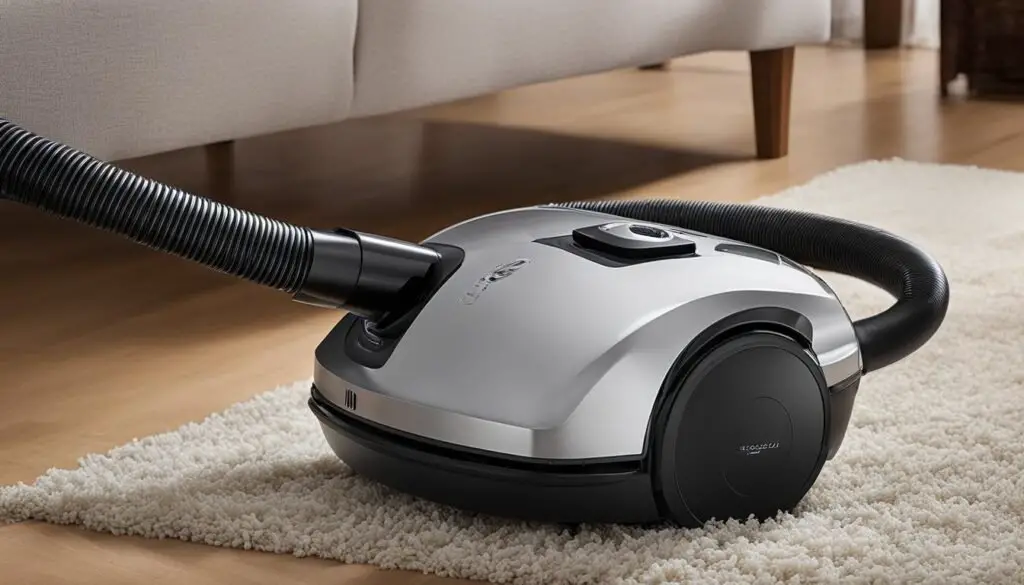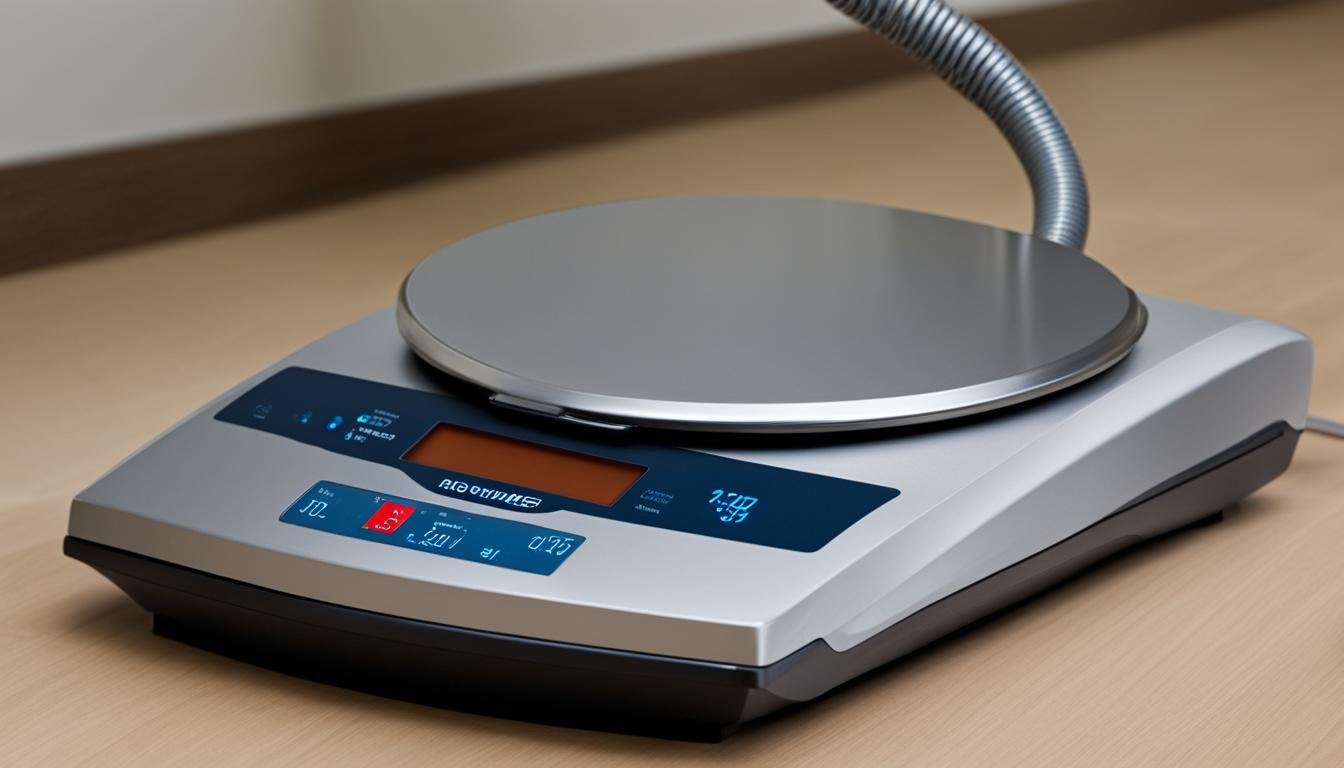A vacuum cleaner is a versatile device that helps keep our homes clean and tidy by removing dirt and debris from various surfaces. But have you ever wondered about the mass of a vacuum cleaner? Just how heavy is this essential cleaning tool? Let’s explore the weights and measurements of vacuum cleaners to understand their impact on usability and storage in our homes.
Key Takeaways:
- The mass of a vacuum cleaner can vary depending on its model and design.
- Different factors, such as the type of motor and components used, contribute to the overall weight of the vacuum cleaner.
- Considering the mass of a vacuum cleaner is essential for determining its portability and ease of storage.
- By understanding the weight of a vacuum cleaner, you can choose the right model that suits your cleaning needs and preferences.
- Stay tuned to learn more about the history, types, and specifications of vacuum cleaners.
History of Vacuum Cleaners
The evolution of vacuum cleaners throughout history has been remarkable. From the first manual models in the 1860s to the powered vacuum cleaners of today, this household appliance has undergone significant advancements.
It all began with the invention of the bellows-based vacuum cleaners in the 1860s. These early models required manual effort to create suction and remove dirt from surfaces. While these bellows vacuum cleaners were an improvement over traditional brooms and rugs, they were still labor-intensive.
The turning point in the history of vacuum cleaners came in the early 1900s with the invention of powered designs. Engineers like Hubert Cecil Booth and David T. Kenney played pivotal roles in the development of these early vacuum cleaners. Booth’s motorized vacuum cleaner, introduced in 1901, utilized suction technology, making it significantly more effective at cleaning than its predecessors.
“The invention of powered vacuum cleaners was a game-changer in home cleaning. It revolutionized the way people maintained cleanliness in their living spaces.” – Hubert Cecil Booth
The introduction of powered vacuum cleaners initiated a boom decade for the industry, with many companies and inventors striving to improve upon the initial designs. These early powered vacuum cleaners provided a significant convenience advantage over manual models, reducing the effort required for cleaning tasks.
Over the years, vacuum cleaner technology has continued to advance. Filterless cyclonic dirt separation, introduced by James Dyson in the 1980s, greatly improved cleaning efficiency and reduced maintenance needs. The advent of rechargeable hand-held vacuums also enhanced the flexibility and convenience of vacuuming for users.
Today, vacuum cleaners are an essential household appliance found in homes worldwide. They offer a range of features and options to cater to different cleaning needs. From upright vacuum cleaners to canister vacuum cleaners, there are various models available to suit individual preferences and requirements.
If you’d like to see a timeline of the history of vacuum cleaners, refer to the table below:
| Year | Development |
|---|---|
| 1860s | Manual vacuum cleaners using bellows are introduced. |
| 1901 | Hubert Cecil Booth invents the first powered vacuum cleaner using suction technology. |
| 1980s | James Dyson introduces filterless cyclonic dirt separation technology. |
Advancements in Vacuum Cleaner Technology
The history of vacuum cleaners is a testament to human ingenuity and the drive for innovation. As technology continues to progress, we can expect further advancements in vacuum cleaner design, efficiency, and functionality. With each new development, vacuum cleaners become more effective in keeping our homes clean and pristine.
Types of Vacuum Cleaners

When it comes to vacuum cleaners, there are several types available on the market to suit different cleaning needs. Let’s explore the various types of vacuum cleaners and their features.
1. Canister Vacuum Cleaner
The canister vacuum cleaner is a popular choice for many households. It consists of a separate canister that houses the motor and dust collection system, connected to a cleaning head via a flexible hose. This design offers great maneuverability, allowing you to reach tight corners and clean stairs easily. Canister vacuum cleaners are known for their powerful suction and versatility on different surfaces.
2. Upright Vacuum Cleaner
The upright vacuum cleaner is a common sight in homes across the United States and the United Kingdom. This type of vacuum cleaner features a cleaning head attached to a handle and a bag for dust collection. Upright vacuum cleaners are known for their convenience and ease of use, as they can be maneuvered with minimal effort. With their wide cleaning paths, they are a great choice for efficiently cleaning larger areas.
3. Cordless Stick Vacuum Cleaner
If portability and versatility are your top priorities, the cordless stick vacuum cleaner is an excellent option. These lightweight and compact vacuum cleaners provide hassle-free cleaning without the limitations of cords. They are designed for quick and easy cleaning, suitable for small spaces and spot cleaning. Cordless stick vacuum cleaners often come with detachable handheld units, making them ideal for cleaning upholstery, stairs, and other above-floor areas.
Each type of vacuum cleaner has its own set of advantages and considerations. While the canister vacuum cleaner offers versatility, the upright vacuum cleaner provides convenience, and the cordless stick vacuum cleaner offers portability. Consider your cleaning needs, the type of surfaces you will be cleaning, and the available storage space in your home when choosing the right vacuum cleaner for you.
Conclusion
When it comes to choosing the right vacuum cleaner for your home, there are several important factors to consider. One of these factors is the mass of the vacuum cleaner. The weight of a vacuum cleaner can impact its portability and storage, so it’s crucial to select a model that suits your needs.
Furthermore, you should also take into account the type of vacuum cleaner that best fits your cleaning requirements. Whether it’s a canister vacuum cleaner, an upright vacuum cleaner, or a cordless stick vacuum cleaner, each type offers different features and capabilities.
Aside from the mass and type, be sure to consider other specifications such as the suction power, maneuverability, and attachments available. These factors play a significant role in determining the cleaning efficiency of a vacuum cleaner and how well it will meet your unique cleaning needs.
By carefully assessing the vacuum cleaner mass specifications and considering all the relevant factors, you can confidently choose the ideal vacuum cleaner that will make your cleaning tasks easier and more effective.
FAQ
What is the mass of a vacuum cleaner?
The mass of a vacuum cleaner can vary depending on its model and design. Factors such as the type of motor and components used contribute to the overall weight of the vacuum cleaner.
How heavy is a vacuum cleaner?
The weight of a vacuum cleaner can range from light to heavy, depending on the model. Canister-style cleaners and cordless stick cleaners are generally lighter, while upright cleaners can be heavier due to their design.
What are the typical specifications for vacuum cleaner mass?
There is no fixed average weight for vacuum cleaners, as it can vary widely. However, canister-style cleaners and cordless stick cleaners usually range from around 5 to 15 pounds, while upright cleaners can weigh between 10 and 20 pounds or more, depending on the model.
How do I measure the mass of a vacuum cleaner?
To measure the mass of a vacuum cleaner, you can use a scale or weigh it using a household weighing machine. Ensure that the vacuum cleaner is empty and properly balanced before measuring its mass.
What factors should I consider when choosing a vacuum cleaner based on its mass?
When choosing a vacuum cleaner based on its mass, consider factors such as portability and storage. If you need a lightweight and easily maneuverable option, you may prefer a canister-style or cordless stick cleaner. If you prioritize power and durability, a heavier upright cleaner may be suitable.
What are the advantages of different types of vacuum cleaners based on their mass?
Canister-style vacuum cleaners are typically more portable and easier to carry around, while cordless stick vacuum cleaners offer even more mobility and versatility. Upright vacuum cleaners are known for their stability and larger cleaning capacities.
How can the mass of a vacuum cleaner affect its usability and storage in my home?
The mass of a vacuum cleaner can impact its ease of use and storage. A lightweight vacuum cleaner may be easier to lift, push, and maneuver around your home. Heavy vacuum cleaners may require more effort to move and store, especially if you have limited storage space.
What other specifications should I consider when choosing a vacuum cleaner?
In addition to mass, consider specifications such as suction power, maneuverability, noise level, attachments, and filtration systems when selecting a vacuum cleaner. These factors can all contribute to the overall cleaning performance and user experience.
Are there any compact and lightweight vacuum cleaners available?
Yes, cordless stick vacuum cleaners are usually designed to be compact and lightweight, making them convenient for quick clean-ups and easily maneuvering around furniture and narrow spaces.





Leave a Reply